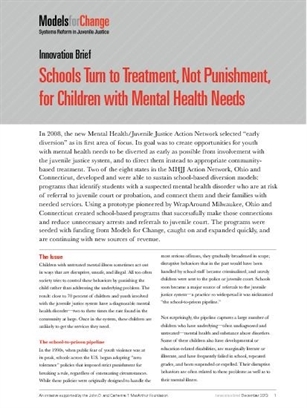Innovation Brief: Schools Turn to Treatment, Not Punishment, for Children with Mental Health Needs
Published Dec 12, 2013, Giudi Weiss, Kathleen Skowyra
Download
(172 KB)

In 2008, the new Mental Health/Juvenile Justice Action Network selected “early diversion” as its first area of focus. Its goal was to create opportunities for youth with mental health needs to be diverted as early as possible from involvement with the juvenile justice system, and to direct them instead to appropriate community based treatment. Two of the eight states in the MHJJ Action Network, Ohio and Connecticut, developed and were able to sustain school-based diversion models: programs that identify students with a suspected mental health disorder who are at risk of referral to juvenile court or probation, and connect them and their families with needed services. Using a prototype pioneered by WrapAround Milwaukee, Ohio and Connecticut created school-based programs that successfully make those connections and reduce unnecessary arrests and referrals to juvenile court. The programs were seeded with funding from Models for Change, caught on and expanded quickly, and are continuing with new sources of revenue.